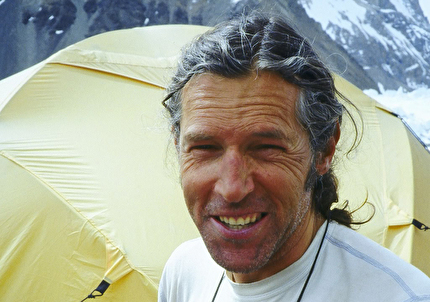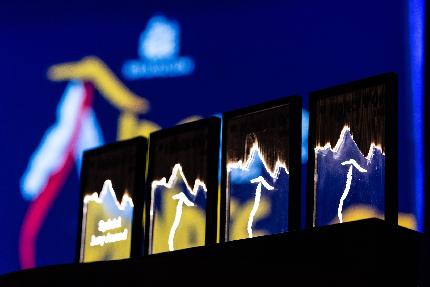Tirich Mir, Jannu and Flat Top win Piolets d’Or 2024, Special Mention to Nives Meroi
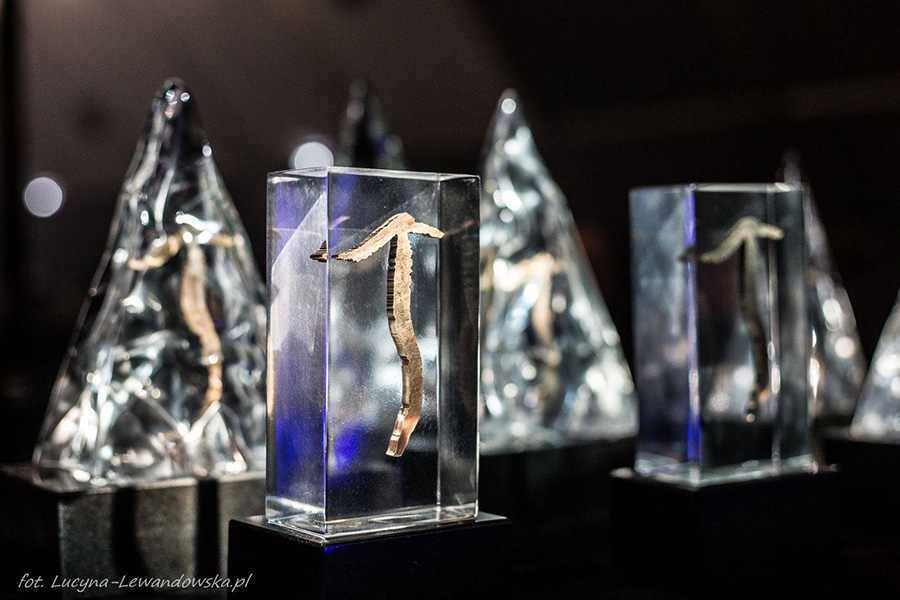
 1 / 33
1 / 33 Lucyna Lewandowska Fotografia
Lucyna Lewandowska Fotografia
The purpose of the Piolets d’Or is not only to recognise the most significant ascents of the previous year, but also to use these ascents to promote clear ethical messages regarding our practices as alpinists. The year 2023 produced a remarkable number of first-rate alpine-style ascents, leading to the international jury of Lise Billon (France), Aleš Česen (Slovenia), Toni Gutsch (Germany), Genki Narumi (Japan), Enrico Rosso (Italy), Jack Tackle (USA), and Mikel Zabalza (Spain) awarding three Piolets d’Or ascents and assigning a Special Mention for female alpinism.
Tirich Mir (7,708m)
First ascent of The Secret Line on the north face of Tirich Mir (7,708m) in the Hindu Kush, Pakistan, from July 17-23. Traversed the mountain by descending the normal route to the northwest.
Tirich Mir is the highest mountain in the Hindu Kush and as such was relatively popular in the latter half of the 20th Century. However, lying in the far corners of northwest Pakistan, very close to the border with Afghanistan, it is accessed through Chitral and has seen almost insignificant activity since 9/11 due to the perceived heightened terrorist threat in that area. For some years, the Japanese alpinist Kazuya Hiraide had been interested in the north face and in 2019 a local agent told him that tourists were now being granted permission to re-enter the area. He applied for a permit but was refused. Then COVID-19 intervened, and it was not until the summer of 2023 that he and Kenro Nakajima reached the mountain.
Direct access to the vast north face of Tirich Mir is blocked by an icefall almost 1,000m high. A Czechoslovakian expedition, which in 1967 established the current normal route via the Upper Tirich Glacier and northwest ridge, first climbed though the icefall to see if there was a route from that side. It has not been climbed since and the intervening years have made it very dangerous. Nakajima commented that he had “never seen an icefall with so much widespread destruction”.
The Japanese pair needed a work-around. Using satellite photos, they plotted a route into the glacier basin below the north face that would follow the initial section of the normal route and then cross a high col on the long northwest ridge of Tirich Mir. After inspecting the col and caching gear, they acclimatized to 6,300m on the normal route, then set out from base camp at 4,600m on July 17. That night they camped at 5,400m and the following day crossed the 6,200m col. The far side was steep and exposed to rockfall in the warmer than normal temperatures that month. Taking a pragmatic approach, the pair fixed four ropes to aid a retreat. Eight rappels and some downclimbing took them to the western end of the basin. That same day they crossed the basin, unvisited since 1967, to the foot of the north face and camped at 5,500m.
Next day, complex route finding led to their third bivouac (at 6,150m), where they were able to use an ice hammock to construct a tent platform. Difficult snow and ice led to a poor fourth bivouac at 6,750m. Above, lay the biggest uncertainty of the route - a large serac barrier. Fortunately, the following morning they were able the left via hard ice and reach Mir and Tirich West I, where they made their fifth bivouac. They had now joined the normal route, which arrives at this point from the far side
On the 23rd Hiraide and Nakajima left their camp and set off for the summit. There were many different lines on the broad upper ridge and the two climbed a couple of steep pitches, which they rappelled during the descent. Mostly, they simul-climbed, reaching the summit at around 9:30 a.m. and regaining their camp at noon. Feeling strong, they continued down the normal route, rappelling the crux couloir to the Upper Tirich Glacier and descending this to 6,300m. Next day they regained base camp.
This long, complex and highly committing adventure was considered by the jury to be a splendid traverse of a high-altitude mountain. Jury members also noted that almost no prior information was available to help with the ascent of the hidden north face. The use of 200m of fixed rope to access the climb (sadly not removed after the ascent) was considered a minor flaw compared to the overall scale of the undertaking and its successful completion.
Jannu (7,710m)
First ascent of Round Trip Ticket (2,700m, M7 AI5+ A0), a partial new route on the north face and northwest ridge of Jannu, Kangchenjunga Himal, from October 7-12. Descended route.
ean Franco, leader of the first expedition to attempt Jannu (a.k.a. Kumbhakarna), said the true north face was “one of the highest walls on earth. No one will ever go that way”. Inevitably, in 2004, he was proved wrong. In that year a large team of Russian mountaineers, on their second attempt in two years, climbed what the legendary Swiss, Erhard Loretan, who had previously made two attempts himself, described as “currently the greatest challenge in the Himalaya”. Their climb was both outstanding and highly controversial. The sheer headwall, which begins above 7,000m, was likened to the west face of the Dru, and the team surmounted difficulties of 5.10d A3+ M6. However, they received widespread criticism of their style: the climbers had sieged the wall, spending 50 days fixing nearly 3,400m of rope and having taken emergency oxygen.
In 2021, Jackson Marvell and Alan Rousseau set up base camp on the north side of Jannu with the intention of repeating the Russian route in alpine style. However, scoping the headwall, they saw another possible line, slanting right to reach the upper northwest ridge at a little over 7,500m. They decided to try this, not least because they would be on pristine ground and not following large amounts of old rope and hardware. The northwest ridge had been climbed in 2007 by Valery Babanov and Sergey Kofanov in alpine style, the final section to the summit coinciding with the 1983 French Route, which reached this point via the southwest spur. This duo had a good view of the north face, on which Kofanov commented, “Perhaps someday a pair will climb a direct route on the north face in alpine style, but they’ll need to accept the likelihood that they’re buying themselves a one-way ticket.”
Marvell and Rousseau reached 7,200m, gaining considerable knowledge of the route. They returned in 2022 with the addition of Matt Cornell. Marvell had to leave early and the remaining two were only able to reach 6,500m due to consistently high winds and cold temperatures
All three returned in 2023, having refined their climbing system while putting up Aim for the Bushes (1,525m, AI6 X M6) on Mount Dickey, Alaska, one of the most significant new routes climbed outside Asia during the year. On October 7, they left base camp with a new, very lightweight, three-man sleeping system that included two inflatable G7 pods (portaledges). They also carried a forecast of seven days’ fine weather.
Climbing through the initial rock buttress, followed by 300m of icefall, they reached and then climbed the steep 1,100m ramp system, which involved challenging alpine terrain over snow, ice and mixed, to arrive at around 7,100m, just below their 2021 highpoint, on the afternoon of the 9th.
Above 7,200m they slanted right up new ground on the steepest section of the wall to reach a full hanging bivouac at 7,300m. On the morning of the 11th, they passed the crux, a more or less vertical thin ice smear followed by convoluted mixed climbing. They bivouacked one pitch below the northwest ridge at 7,500m. Next day, they finished up the 1983 French Route, reaching the summit in late afternoon. They regained the pods by 11 p.m., and on 13th rappelled the route, mostly from Abalakovs, arriving at base camp around midnight.
Marvell and Rousseau knew that several of their fingers were frostbitten. Discussing options on the following day, they realized that walking out through the jungle for five days, and then driving for three more days to reach Kathmandu, would present a significant risk of infection. They were also told by friends in the USA that a clinic in
Kathmandu offered an intravenous treatment, which if administered within 72 hours might reverse some of the injuries. They opted to call for a helicopter. The subsequent treatment eventually limited the damage to the loss of the tip of one little finger for both climbers.
The jury was unanimous: this was an extraordinary ascent that has taken technical alpine style climbing at high altitude to a new level. A combination of great teamwork, visionary strategy, technical ability and experience, together with an evolution in equipment, has led to a new chapter in the history of Himalayan ascents and will be an inspiration for future generations.
Flat Top (6,100m)
First ascent of Tomorrow Is Another Day (1,400m, ED, 5c A2 WI4 M6) on the north face of Flat Top in the Kishtwar Himalaya, from October 2-6. Descended the unclimbed west face.
The granitic alpine peaks of India's Kishtwar Himalaya lie in the disputed territory of Jammu and Kashmir, a region that for many decades has been a scene of conflict between Indian armed forces, militants and separatists. It is an Indo-Pakistan situation that has, to a greater or lesser extent, rumbled on since the Partition of 1947. The 1970s and ‘80s were the heyday of climbing in this region, after which widespread insurgency led to the area becoming a no-go for foreign climbers, especially access from the west through the town of Kishtwar. Recently, the situation has improved and the many beautiful unclimbed lines that remain are now ripe for the picking.
One such gem is the north face of Flat Top (6,100m) in the Brammah Group, a mountain that had seen only one previous ascent, in 1980 by the east ridge. In 2018, a two-man Anglo-New Zealand team climbed about 700m up the north spur but were defeated by bad weather. Their subsequent attempt on the east ridge also failed.
After a forecast of a four-day weather window, three young Swiss alpinists, Hugo Béguin, Matthias Gribi, and Nathan Monard, left their advanced base on October 3, 2023. In perfect weather they followed an obvious line in the centre of the north face, slanting right after 600m to reach the crest of the north spur. That rising traverse to gain the spur, climbed on the second day, proved to be the crux. Above, steep technical climbing on the crest, or where this was not possible on the left flank, led to the summit at 7 p.m. on October 6, after which the three descended the untouched west face of the mountain (15 rappels) to bivouac on the glacier west of their approach route. Next day they crossed the long ridge that connects with Brammah I, rappelled the far side, and regained their advanced base.
The jury felt this was an elegant and technically difficult line on an attractive peak, and in an area little visited in the last 40 years. It was climbed in perfect alpine style and the mountain traversed without incident.
The 2024 Special Mention for Female Alpinism
The Piolets d’Or aims to promote female alpinism by making either a Special Mention to an all-female expedition completing a significant ascent in the Greater Ranges, or to a female or females taking a lead role in a mixed group ascent, or a single female for major multiple mountaineering ascents through the years. In 2024 the mention is for a single female - the Italian Nives Meroi.
In 2023, arguably the most notable new route at altitude by a party involving a female alpinist was Diamonds on the Soles of the Shoes on the west face of Kabru South (7,318m) in the Kangchenjunga Himal. It was the second ascent of the most southerly 7,000m peak in the world, and the first successful ascent to any of the Kabru summits from Nepal. After an initial reconnaissance, followed by a failed attempt to 5,600m, Peter Hámor, Bojan Jan, and the husband-and-wife team of Romano Benet and Nives Meroi, climbed the face alpine style in four days.
Benet and Meroi are best known for climbing on the 8,000m peaks as a two-person team, with little or no support above base camp. They have always climbed without supplementary oxygen, and mostly without fixed camps (they move up carrying their own tent). On eight of the 8,000ers they climbed the route as the first party of the season, before it had been equipped. The pair climbed Xixabangma and Cho Oyu within the space of 10 days, and Gasherbrum I, II, and Broad Peak within the space of 20 days. Meroi was the first Italian woman to climb Everest without oxygen. However, in 2009, at 7,500m on Kangchenjunga, Benet became increasingly weak and tried to persuade Meroi to continue to the summit alone. She refused, the two turned around, and Benet made it down safely with Meroi’s help. His illness proved to be severe, and it wasn’t until 2014 they were able to return to the mountain – and summit.
Benet and Meroi met at the end of the 1970s when she was 19, and they eventually married in 1989. For many years the two have lived in the Julian Alps, close to the Slovenian border. There, they have climbed many routes including the Helba on the north face of Triglav, and first winter ascents of the North Pillar (Bellini-Perissutti-Piussi) on Piccolo Mangart di Coritenza and Comici’s 10km Ledge of the Gods on Jôf Fuart. In the adjacent Carnic Alps they have repeated the infrequently climbed North Ridge Integral on the Sfinge della Grauzaria. In the Dolomites their routes include many hard classics such as the Brandler-Hasse on the north face of the Cima Grande di Lavaredo, the Spigolo Strobel on the Rocchetta Alta di Bosconero, and the Lacedelli and Skotonata Galactica routes on Cima Scotoni.
Further afield, they climbed in Peru, in the Gangotri where they made a new route on the north face of 6,512m Bhagirathi II, and Xinjiang, where they attempted the then unclimbed Chinese side of Gasherbrum II. They were unsuccessful on the latter but were able to summit several previously unclimbed peaks up to 6,500m.
Unlike many mountaineers who appear to give up serious mountaineering after their journey through the 8,000m peaks, Meroi has continued to try major high-altitude ascents, witness Kabru and a more recent attempt on Yalung Peak. She also displays a very high regard for the truth. In 2010, Meroi received the Order of Merit, the highest Italian state award, and in 2016 the couple received the King Albert I Mountain Award.
Info: pioletsdor.net



 Copia link
Copia link

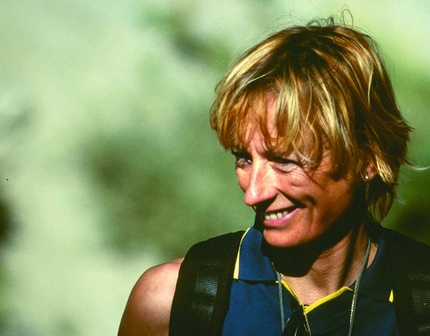
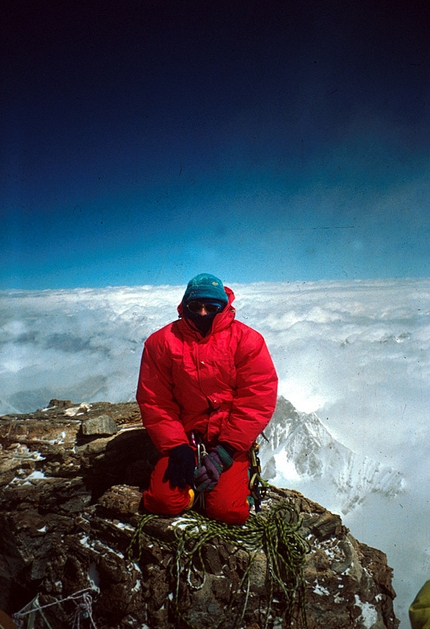












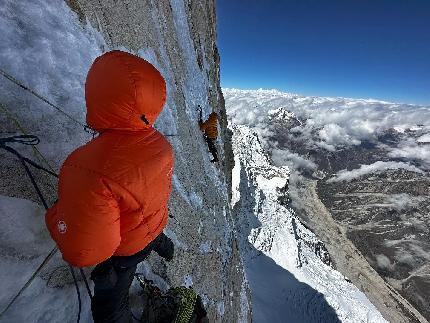

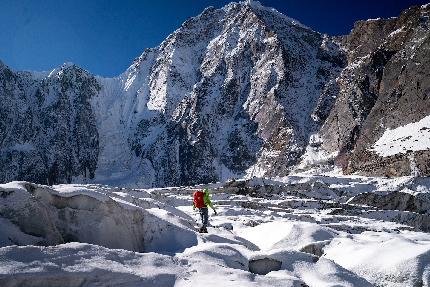

 See all photos
See all photos